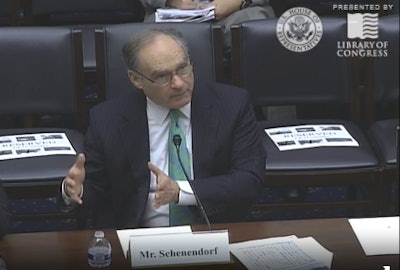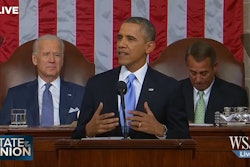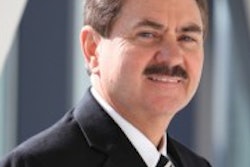Trucks need to pay more to use the nation’s highways – that’s the essence of a recent hearing on funding the nation’s freight system.
With the clock ticking on the bill that funds America’s highways and bridges, a congressional panel called on a pair of experts who had reported – extensively – to Congress five years ago. And Jack Schenendorf and Robert Atkinson picked up right where their respective commissions left off, letting the House transportation committee’s Panel on 21st Century Freight Transportation know that there’s a price to be paid for neglect of the country’s infrastructure.
 Jack Schenendorf testifies Oct. 10 before the Panel on 21st Century Freight Transportation.
Jack Schenendorf testifies Oct. 10 before the Panel on 21st Century Freight Transportation.Schenendorf, who led the National Surface Transportation Policy and Revenue Study Commission, told the panel he was “disappointed” so little had been done since the commission presented its findings in 2008.
“Everybody agrees and can recognize what’s happening, but nobody wants to raise money. The studies could fill this room that have come to the same conclusion: We need to invest more,” Schenendorf said. “But then when you start talking about how we’re going to pay for it, nobody wants to raise taxes, nobody wants more tolls or user charges. Consequently, the investment has not been made and the system functionality is deteriorating.”
Truckers and the shipping community are willing, even asking to pay more, he explained, as long those fees are fair and invested wisely, he explained.
“They’re less competitive because the system is less reliable,” Schenendorf said. “Inaction is becoming more costly than actually raising the investment to improve reliability.”
Schenendorf suggested an “all of the above” approach for transportation funding, including the use of infrastructure banks and public-private partnerships to close the funding gap created by a dwindling highway trust fund.
His “outside-the-box” funding ideas included a “targeted” Federal Interstate User Fee, collected through an automated toll system, and a Federal Motor Carrier User Fee for non-interstate truck travel, collected through a “GPS-type” system.
“The fees would be set the level necessary to pay for improvements – no higher, no lower,” Schenendorf said.
Atkinson, who chaired the National Surface Transportation Infrastructure Financing Commission, also proposed specific steps to increase funding from trucks. For the short term, he recommended that Congress should increase existing truck taxes, including doubling the Heavy Vehicles Use Tax and along with raising diesel fuel taxes.
For the near future, he recommended that Congress should require trucks to move to a vehicle miles traveled tax system (VMT) and that all other taxes paid by trucks be eliminated. Along with that, he said Congress needs a better cost study “to find out what trucks really do pay” compared to the cost burden they impose.
He also suggested Congress should remove state limitations on tolling the interstates.
Ultimately, he recommended that all vehicles go to VMT assessment.
“Having a VMT system allows a more efficient system of pricing that’s related to costs imposed,” Atkinson said. “That’s a complex endeavor to be sure, but that’s why I recommend we start with a VMT system for trucks. They’re much easier to do and the advantages would be significant because trucks impose a much higher cost that VMT could charge for.”
The American Trucking Associations came out in opposition to the VMT and tolling proposals when the commissions first presented them. ATA instead has called for increases to the fuel tax.
The political headwinds will indeed be strong, regardless of what the panel recommends to the full committee next week.
“I don’t think what needs to be done can be done by one political party. It’s not going to change until the two parties can come together and say, ‘this is what’s right for America,’” Schenendorf concluded.










